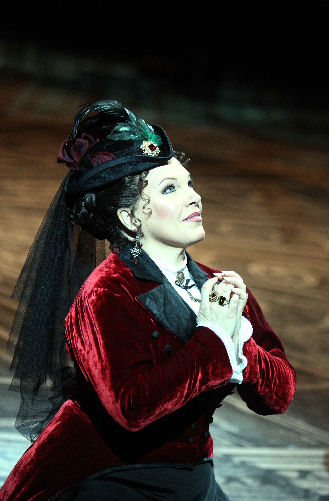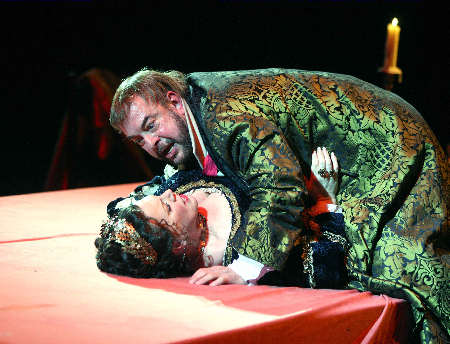Other Links
Editorial Board
- Editor - Bill Kenny
- London Editor-Melanie Eskenazi
- Founder - Len Mullenger
Google Site Search
SEEN
AND HEARD OPERA REVIEW
The Raymond Gubbay Tosca:
Soloists, chorus, actors and children, David Freedman (director),
David Roger (designer), Royal Philharmonic Orchestra, Peter
Robinson (musical director). Royal Albert Hall, London 28.2.2008 (JPr)
The announcement that the television broadcasts from the New York
Metropolitan Opera have been going on for a couple of years came
as something of a surprise to me. And after the promise of more
cinema presentations this Spring of seven operas from La Scala and
two other Italian opera houses - comes the press release from
Covent Garden that performances from Royal Opera and Royal Ballet
will be similarly screened in cinemas worldwide, although not here
at home. This feels like a seriously missed opportunity for one of
our great institutions to spread the word that opera and ballet
really can be accessible for everyone, rather than maintaining the
myth of elitism so prevalent in the UK.

Cynthia Lawrence as Tosca
The setting is much less successful for Act II and Scarpia’s room
in the Palazzo Farnese. A massive red table is featured with
Scarpia and Tosca seated at opposite ends and the ‘interrogation’
of Cavaradossi is all too visible: Tosca should be able to hear
Cavaradossi's screams but should not turn round to watch him
suffer. The distance the artists have to cover and the time they
have to do it in creates other problems too. It's probably a minor
niggle but when Scarpia sings ‘You can fetch the painter in’,
Cavaradossi is halfway down some stalls steps and already in full
view. But while the entry of the priests, children and crowds for
the Te Deum in Act I had also used the same steps through
the audience, that scene felt impressively staged because there
was enough time available for all of it.
Hats off then to Raymond Gubbay, one of the pioneers in bringing
classical music and opera to the masses here! Raymond Gubbay began
small and I recall many wonderful Johann Strauss concerts with the
equally splendid Willi Boskovsky opera galas, Christmas festivals,
and Gubbay's eventual branching out into arena opera and then
opera ‘in the round’. Early attempts were a bit rough and ready
and there were problems with the music and sound reproduction. But
since 1998 the Australian, David Freeman, has directed Madam
Butterfly, Carmen, Tosca and Aida for
Raymond Gubbay bringing these operas to large crowds and earning
more appreciative noises from critics.
That Gubbay attracts a different crowd than would be seen at the
Covent Garden or ENO is more than apparent when it becomes clear
that it is the heroine’s fall of some twenty feet to her ‘death’
at the end of the evening which generates the greatest ovation and
we hear Scarpia being booed – not for poor singing – but because
of his ‘pantomime villain’ nature. Full credit however goes to the
Tosca, in this latest Gubbay production, the American Cynthia
Lawrence who has a gymnastic background apparently, takes this
impressive fall herself: the other Tosca in a double cast, Paula
Delligatti will make a brief disappearance at the top of a flight
of steps to swap with a stunt double.
I am newly back to this ‘opera in the round’ and have neither seen
Carmen nor Madam Butterfly. While I can imagine
Carmen using up the available spaces well, the latter, like
Tosca, is another rather intimate affair in which vast ‘acres’
of the performing space may lie unused for large stretches of
time. My feeling is that this 1999 Tosca production might
have worked even better using only half the available area
although David Roger’s Napoleonic designs worked well of course
for the Sant’Andrea della Valle church: there were plenty of
candles and incense burners hung down and metal railings lay
around the perimeter outlining the chapel recesses. The space is
also very apt for the end of the opera at the Castel Sant’Angelo.
Here, there is a large replica of the Archangel Michael on the
parapet from which Tosca leaps and the metal work is also cleverly
brought centre-stage to construct a cage within which Cavaradossi
is shot like a wounded zoo animal.

Cynthia Lawrence (Tosca) and Peter Sidhom (Scarpia)
While I enjoyed the production enormously, its lack of intimacy
does mean that some big moments were seriously fluffed. Scarpia’s
entrance in Act I lost its impact because there were just so many
other things to look at that it took time to find him in the
crowd. The biggest problem by far though was that Tosca's Act I
jealousy and Scarpia's Act II lust could only be displayed by the
characters doing laps round the arena and when Scarpia got his
hands on Tosca on top of the table, they looked as though they
were auditioning for the Sumo Wrestling that Gubbay stages in the
Royal Albert Hall next year.
The amplified singing did allow most of Amanda Holden’s English
translation to be heard clearly, at least from my seat in the
Stalls but, strangely, in the big moments of the two Cavaradossi
arias and in Tosca’s 'Vissi d'Arte', regardless of some fine
singing, the words became unrecognisable – perhaps actually
because I know their sound so well from the original Italian? I
did wonder why the opening Italian line so often became the second
English one in the translation too. ‘E lucevan le stelle ...’
became ‘I remember an evening/when the stars shone so brightly’
and ‘O dolci mani! … ’ was ‘O let me kiss those/hands so soft
and gentle’. Or maybe I'm just being picky?
Finally what about the singers? There was considerable experience
from the two principals. Joseph Wolverton, another American, was
certainly a bear-like Cavaradossi and while he didn't seem to do
any painting, he had a secure, quite baritonal voice with a firm
top: he overdid the sob and pain in his voice however, and might
usefully have let the notes register their own emotions. Cynthia
Lawrence was a convincing Tosca – equally as at home in riding
clothes complete with horse whip in Act I as in the black dress
with gold trimmings and shawl for Act II. Her soprano voice was
ardent and angry when necessary but could also be delicately
softened; at least as delicately as the vast spaces would allow.
What she and Peter Sidhom’s Scarpia lacked was a real dramatic
presence with what I might describe as the ‘I’m It!’ look about
them. She was insufficiently the ‘Diva’ and he lacked the quiet
menace his position of power should give him. Peter Sidhom is an
excellent Alberich and as Scarpia was still wonderful as Alberich!
Scarpia is in fact a far different character to the Nibelung and
Sidhom's voice lacked the hauteur and potency necessary, though he
was much better in Act II than when struggling through Act I which
left me thinking he must have been suffering an unannounced
illness.
Standing out amongst the smaller parts was Richard Mosley-Evans’s
Sacristan who had a voice good enough for Scarpia himself. Ben
Whittington’s shepherd boy sang ‘Unhappy lover your pain will soon
be over’ very sweetly but I didn’t really warm to the gaggle of
street urchins rushing on, complete with football, at the start of
Act III. They looked like refugees from Oliver only there
to illicit the ‘ahhhhhhhs’ from the audience.
As I say, I do not want to give the impression of not enjoying the
performance which I most certainly did in its own terms. At the
end I was a moved by Tosca’s plight and thoroughly entertained by
Puccini’s ‘shabby little shocker’ just as I should be. The sound
was crystal clear and the amplification process did not intrude on
my expectations of what I should be hearing. It was only very
occasionally that the, often very well thought through, off-stage
singing, bells and drums felt a bit unbalanced such as at the
start of Act II where the ‘concert’, supposedly outside and heard
through windows, was rather too loud. The experienced conductor,
Peter Robinson, led a very clean account of the score which was
well-played by members of the Royal Philharmonic Orchestra. He
was probably supporting his singers in these special circumstances
by never seeming very hurried.
Jim
Pritchard
Back
to Top
Cumulative Index Page
